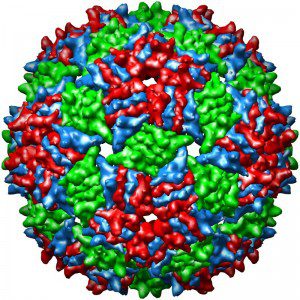

By the 1950s it was well known that different strains of the bacterium Escherichia coli could exchange genes in a process called recombination. Zinder wanted to know if other bacteria could also exchange genes in a similar manner, and therefore began to study Salmonella typhimurium. The strains that Zinder used for his experiments were lysogens: their chromosomal DNA contained integrated copies of the DNA genomes of bacteriophages. Zinder readily detected genetic exchange in Salmonella, but suspected that the latent phages might play a role. To test this idea, he grew Salmonella in tubes that were connected by a fine filter that allowed passage of viruses but not bacteria between the two cultures. The results showed that a filterable agent, or virus, could mediate the exchange of genetic material between bacterial strains; direct contact between bacteria was not necessary. The authors coined transduction to describe this process. We now understand that transduction occurs because bacteriophages may incorporate bacterial DNA into the viral particle. Transduction remains a common tool to stably introduce a foreign gene into a host cell.
Zinder describes the discovery of RNA-containing bacteriophages, which took place after he had moved to The Rockefeller University, in the Preface to RNA Phages:
In the late fifties, Tim Loeb, a new graduate student at The Rockefeller University, came into my laboratory and asked whether I thought it was possible that there were male-specific bacteriophages for E. coli. I….quickly responded in the affirmative and off he went to a raw sewage plant in New York City. …f2, the second isolate, was chosen for further study. Little did we think at the time that a whole new area of study was in the offing….
The first two bacteriophages that Loeb had isolated from New York City sewage were called f1 and f2. During purification of the phages it was clear that the genome of f1 was DNA. Chemical analyses subsequently demonstrated that the genome of f2 was RNA (later found to be positive-strand RNA). Similar phages were since isolated all over the world, and their study provided much basic information on viral replication, protein biosynthesis, and genome replication. The first genome sequence determined was in 1976 for the related RNA bacteriophage MS2.
Update: Moving eulogy by Jeffrey Ravetch in Eulogy for a brilliant mentor and teacher.
Loeb, T. (1961). A Bacteriophage Containing RNA Proceedings of the National Academy of Sciences, 47 (3), 282-289 DOI: 10.1073/pnas.47.3.282

It would be of interest to me how Martha Chase and Alfred Hershey reacted to the second discovery! That would make a great story!
Indeed. Unfortunately Hershey and Chase are no longer with us so we can’t ask for their recollections. We depend upon the historical record, and I am not aware of any comments from the two about this. But I do know who to ask….
On a related note, Hershey and Chase were fortunate to have used a bacteriophage in their experiments that injects its DNA into cells. There are other phages that  put both protein and nucleic acid into cells….if they had used one of those in their blender experiment, what would they have concluded?
If they had used one of those phages, I think our central genetic dogma would look slightly different today!
Dear Dr. Racaniello,Â
Thanks for the kind words about my father. He was a proud alumnus of Columbia.
As to the reactions of Hershey and Chase, I don’t know, but my father and Al Hershey were good friends and spoke often. Something somewhat related, in my father’s 40th anniversary historical review on transduction in Genetics, he describes how at the 1951 meeting at Cold Spring Harbor, Harriet Ephrussi-Taylor was the first to suggest that the mysterious genetic exchange that wasn’t prevented by a filter could involve bacteriophage. That sent him on the right path.
Steve Zinder
Professor of Microbiology
Cornell University
Seeing as I studied virology as an undergrad in the mid-70s, the name Zinder came up quite a lot. I also remember having to explain transduction during an oral exam in 1976…I did NOT do it well! Thanks! We need more of these histories – a whole generation that helped invent our science is moving on, and their stories need to be told.
Studying virology/micro in the last few years, the name Zinder never came up – this says a lot. And backs up your point exactly! Thanks Vincent.
I am starting a podcast about pioneers in scientific history. I’m putting a few episodes together now and will be working on the website next. I’m hoping to start in May/June and do it every two weeks. Please make sure you check it out!